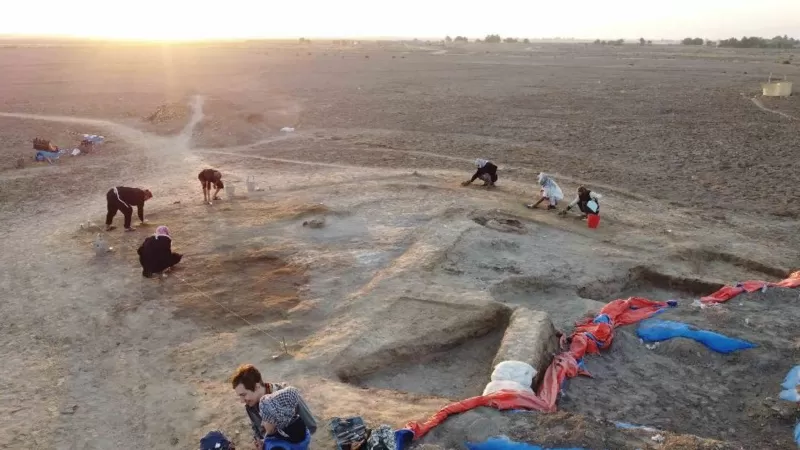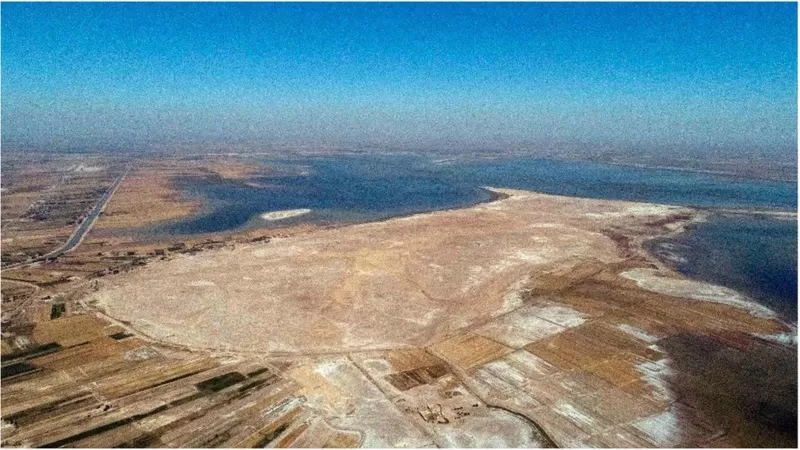?What did scientists find inside a 5,000-year-old bar

The bar was found at the archaeological site of Lagash in Iraq
At a depth of only half a meter, archaeologists in Iraq have found what looks like a tavern dating back to about 2700 BC in the Sumerian city of Lagash in the south of the country.
"The site includes a large common area, which may have been where the food was eaten," Sara Pesementi, from Italy's University of Pisa, told the BBC.
Pezymenti is a member of a team of researchers who have been studying the ancient city for five years as part of the Lagash archaeological project.
?What is the curse of the goddess of love, Ishtar, revealed by writer Agatha Christie
Lagash was one of the largest cities in southern Mesopotamia (Mesopotamia) and is considered one of the oldest urban centers in the world.
The city was part of the Sumerian civilization, which was a group of urban centers on the banks of the Tigris and Euphrates rivers and lasted from the late Neolithic period until the early Bronze Age.

The primitive refrigerator found at the tavern site in Lagash
5,000 year old benches, oven and refrigerator
Using new technologies such as drone imaging and geomagnetic surveys that allow archaeologists to "see" what is beneath the Earth's surface, the team has been able to carry out precise excavations.
After locating the tavern, benches were found, what looked like an earthenware refrigerator, an oven and the remains of storage vessels, many of which still contained food remains.
Project manager Holly Bateman told the BBC: "Thanks to the type of pottery we found at the site, the inscriptions on the gemstones and the carvings, we know definitively that the bar is approximately 5,000 years old."

Scientists found about 100 bowls for preserving and serving food
?But how does the refrigerator work without electricity
A deck cooler or two-tub refrigerator (tub within a tub) is based on the principle of evaporation.
The outer pottery basin lined with wet sand contains a pottery inner pot coated with glass to prevent liquids from leaking into it, and to keep food inside. Evaporation of the liquid in the first basin draws heat from the inner basin. Anything can be cooled in this tub that served as a refrigerator in those days.
Lagash is located on the Tigris River, north of its meeting point with the Euphrates River. It was a thriving trade center during the Early Dynastic Period, which lasted from 3200 to 2900 BC, a period that saw the emergence of some of the world's first cities.
A 95-year-old Australian woman is accused of looting antiquities from the Middle East
Tammuz: The Living Dead God and the Legend of Eternal Love
What is the story of the "secret messages" of the first businesswomen in history from the Iraqi city of Assyria?
"We're trying to understand how this city evolved from one of the small sites that were common in the region in earlier periods into a much larger, more integrated network of cities," archaeologist Reed Goodman from the University of Pennsylvania told the BBC.

The city of Lagash extended over an area of 1,900 meters in length and 3,600 meters in width
5,000-year-old food remains
Next to the oven and the clay fridge, the archaeologists found another room with food bowls, cups, and utensils. And these pots and cups were not empty.
"We found more than 100 bowls with leftover food in them, which made us think that people were frequenting this place at that time to sit in it to eat or drink something," Pesementi said.
She said the place could not have been a home kitchen "because of the huge amount of food that was being prepared in it".
Traces of food reveal that people who frequented the tavern 5,000 years ago ate fish there.
"Inside some of these vessels we found a large amount of fish bones, very well preserved," Bateman said.
But what baffles archaeologists is the reason for not eating.
"All the things we found at the site were left as they are," Pesementi said. "Suggesting that something happened, but we don't know what it is and that's something we want to find out."
Missing piece of the puzzle
The scientists also wanted to know who frequented the bar and their marital status.
Previous excavations at the site revealed that the city of Lagash had three cult complexes where the upper classes lived.
Scientists believe that the tavern was not located in the upscale part of the city.
"The neighborhood where the bar was found doesn't seem to have been in the elite area," Pesementi said. "It appears to have been a neighborhood frequented by ordinary people."
Scientists believe that the tavern was a place where people who worked away from their home could eat their daily meals.
"What we want to find out is whether these people worked in the production of ceramics," Pittman said. The team is eager to learn more about the lives of ordinary people in Lagash.
"We're hoping to get a more balanced and comprehensive account of the population of these cities, because the long-held narrative about these early places of civilization was that they were societies of only the rich and the poor, and a very small class in between," says Goodman.
Source : websites

